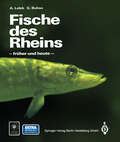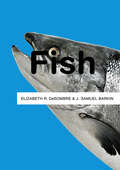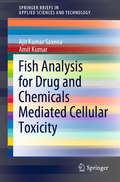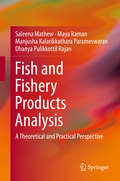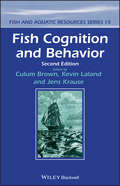- Table View
- List View
Fische des Rheins: — früher und heute —
by Anton Lelek Günter BuhseDer Rhein wird häufig als der schmutzigste Fluß Europas bezeichnet. Fest steht, daß er einen Wandel vom sauberen Lachsstrom zum beinahe "toten" Gewässer in den 70er Jahren hinter sich hat. Trotz aller Ereignisse war der Rhein niemals fischleer. Nach der Verbesserung der Wasserqualität Anfang der 80er Jahre hat sich der Fischbestand schnell erholt. Die Autoren wollen den Leser mit allen im Rhein lebenden Fischen vertraut machen. Dazu wurde der Rhein auf ganzer Länge, von Basel bis Emmerich, auf die vorhandenen Fischarten untersucht, und der heutige Bestand wurde mit den früher dort lebenden Fischgemeinschaften verglichen. Die wissenschaftliche Information ist so aufgearbeitet, daß sie jeder Laie verstehen kann. Die Fische werden beschrieben, in Zeichnungen und Farbbildern anschaulich gezeigt, ihre Lebensansprüche und ihre Verbreitung werden dargestellt. Gleichzeitig wird erklärt, warum bestimmte Fischarten relativ häufig vorkommen, andere aber völlig fehlen. Die Veränderungen und Belastungen des Flusses mit ihren Auswirkungen auf die Fischfauna sind chronologisch dargestellt; die Beschreibung des Ist-Zustands basiert auf umfangreichen Freilandarbeiten. Der Leser wird erkennen, daß der Fischbestand im Rhein den Zustand eines verbauten Flusses wiedergibt. Eine dauerhafte Erhaltung aller Fischarten wird nur mit Hilfe von ökotechnischen Maßnahmen, besonders im Bereich der Nebengewässer, der Flußauen und der einmündenden Zuflüsse möglich sein. Ein "Öko-Buch", nicht nur für Biologen oder Angler!
Fischer-Tropsch Synthesis, Catalysts, and Catalysis: Advances and Applications
by Burtron H. Davis Mario L. OccelliWith petroleum prices spiraling upward, making synthetic fuels-or "synfuels"-from coal, natural gas, and biomass has become more economically competitive. Advanced energy companies now focus exclusively on alternative fuels, and many oil companies have programs dedicated to developing synthetic fuels. The Fischer-Tropsch process, which uses a colle
Fischer-Tropsch Synthesis, Catalysts, and Catalysis: Advances and Applications
by Burtron H. Davis Mario L. OccelliWith petroleum prices spiraling upward, making synthetic fuels-or "synfuels"-from coal, natural gas, and biomass has become more economically competitive. Advanced energy companies now focus exclusively on alternative fuels, and many oil companies have programs dedicated to developing synthetic fuels. The Fischer-Tropsch process, which uses a colle
Fish: Reducing Fishing Capacity To Promote Sustainability (Resources #6)
by Elizabeth R. DeSombre J. Samuel BarkinFishing has played a vital role in human history and culture. But today this key resource faces a serious crisis as most species are being overfished or fished to their very limit. Governments have tried to tackle the problem with limited success. Many of their actions have been counterproductive or ineffective. What will happen to global fisheries, and the populations that depend on them, as we continue to catch more fish than the oceans can reproduce? This book explores the causes of the current crisis in the world's fisheries, and what needs to be done to address the situation. It explains the structure of the fishing industry, the incentives that persuade individuals or companies to catch fish at unsustainable levels, and illuminates the problems created by governmental efforts to use fishing policy as a tool for economic development or to win votes in domestic elections. It also looks at the role of aquaculture in either decreasing or increasing the pressure on wild fish stocks. The dire condition of fish stocks has led governments and consumer organizations to consider new approaches to protect the global supply of fish. DeSombre and Barkin conclude by showing how such methods, along with new forms of international regulation and informed decision-making by consumers, all have an important part to play in rewarding and thus encouraging sustainable fishing behaviour in the future.
Fish Analysis for Drug and Chemicals Mediated Cellular Toxicity (SpringerBriefs in Applied Sciences and Technology)
by Ajit Kumar Saxena Amit KumarThis book offers a comprehensive overview of drug and chemical cellular toxicity, especially concerning the effects of anticancer drugs (cyclophosphamide, methotrexate and phosphamidon) on chromosomes and proteins. It covers histological changes in rat testis during pre- and postnatal exposure to varied drug doses, along with laboratory findings on arsenic exposure and alcohol consumption producing neurological changes and deleterious effects on reproductive health in animals. The book offers essential information on the role of anticancer drug- / chemical-mediated toxicity in connection with genetic changes in the brain and reproductive health, making it a valuable guide for researchers working in the areas of cancer research, infertility, molecular diagnostics and modern drug discovery, at biochemical and toxicity laboratories, and in genetic predisposition and molecular biology in general.
Fish and Fisheries in Estuaries: A Global Perspective
by Michael Elliott Kenneth W. Able Alan K. Whitfield Stephen J.M. BlaberFish and Fisheries in Estuaries: A Global Perspective brings together the current state of knowledge of estuarine fish in one inclusive work. Featuring contributions by more than fifty internationally-recognized researchers and estuarine ichthyological specialists, this landmark resource covers fish assemblages and functional groups, recruitment and production in estuaries, feeding ecology and trophic dynamics, fisheries and the conservation of estuarine fish, and much more. Thirteen in-depth chapters and two method appendices examine major aspects of fish and fisheries in estuaries throughout the world. The text describes the biology of estuarine fish and their connections with estuarine and adjacent marine and freshwater ecosystems, as well as examining the ways human industrialization and global events such as climate change are impacting both native and non-native species. Topics include habitat diversity, fish foraging behavior, ecological engineering tools and models, hazards and risks to estuarine fish and fisheries, and estuarine environmental health. Offering detailed information on the biology and ecology of estuarine fish and fisheries, this authoritative reference: Explores current approaches and future research directions aimed at achieving a balance between exploitation and conservation of estuarine fishes Discusses environmental quality objectives and sustainable management of estuary fisheries Addresses the impacts of increased human use of resources such as food, space, and water to estuarine fish and fisheries Features numerous international case studies of management of fisheries, threatened species, estuarine rehabilitation, reproduction and ontogeny, and others Covers study and sampling methods, field equipment, and data processing, analysis, and interpretation Fish and Fisheries in Estuaries: A Global Perspective is an indispensable tool and reference point for fish biologists, fisheries scientists, ecologists and environmental scientists, aquatic ecologists, conservation biologists, estuarine managers and advanced students and instructors in fish biology and fisheries programs.
Fish and Fisheries in Estuaries: A Global Perspective
by Michael Elliott Stephen J. M. Blaber Kenneth W. Able Alan K. WhitfieldFish and Fisheries in Estuaries: A Global Perspective brings together the current state of knowledge of estuarine fish in one inclusive work. Featuring contributions by more than fifty internationally-recognized researchers and estuarine ichthyological specialists, this landmark resource covers fish assemblages and functional groups, recruitment and production in estuaries, feeding ecology and trophic dynamics, fisheries and the conservation of estuarine fish, and much more. Thirteen in-depth chapters and two method appendices examine major aspects of fish and fisheries in estuaries throughout the world. The text describes the biology of estuarine fish and their connections with estuarine and adjacent marine and freshwater ecosystems, as well as examining the ways human industrialization and global events such as climate change are impacting both native and non-native species. Topics include habitat diversity, fish foraging behavior, ecological engineering tools and models, hazards and risks to estuarine fish and fisheries, and estuarine environmental health. Offering detailed information on the biology and ecology of estuarine fish and fisheries, this authoritative reference: Explores current approaches and future research directions aimed at achieving a balance between exploitation and conservation of estuarine fishes Discusses environmental quality objectives and sustainable management of estuary fisheries Addresses the impacts of increased human use of resources such as food, space, and water to estuarine fish and fisheries Features numerous international case studies of management of fisheries, threatened species, estuarine rehabilitation, reproduction and ontogeny, and others Covers study and sampling methods, field equipment, and data processing, analysis, and interpretation Fish and Fisheries in Estuaries: A Global Perspective is an indispensable tool and reference point for fish biologists, fisheries scientists, ecologists and environmental scientists, aquatic ecologists, conservation biologists, estuarine managers and advanced students and instructors in fish biology and fisheries programs.
Fish and Fishery Products Analysis: A Theoretical and Practical Perspective
by Saleena Mathew Maya Raman Manjusha Kalarikkathara Parameswaran Dhanya Pulikkottil RajanThis novel and informative book discusses the various aspects of seafood quality. The book is divided into 7 broad sections, each tackling a different aspect. The first section covers the general aspects relevant to the nutritional quality of the fish and the various extraction protocols for macro-/ micro-nutrients. The second section provides insights into handling and the principles of thermal and non-thermal processing techniques for commercially important fishery products. The quality standards and safety concerns in the seafood industry and consumption are discussed in this section. The freshness indices of the processed products including biochemical, microbiological and toxicological characteristics are also included. The third section discusses the physico-chemical characteristics and quality parameters of potable water/ ice. The fourth section includes the quality assessment of various toxicants related to seafood products. The fifth section deals with the specific aspects such as principle, instrument and procedures of conventional and novel analytical instruments relevant to the seafood industry. The sixth section deals with the seafood waste management including solid and liquid seafood wastes. Presently, there is a great awareness regarding environmental sustainable processing/ preservation techniques. The final chapter discusses the bioactive compounds from under-utilized marine sources showing pharmaceutical/ nutraceutical applications.
Fish Behavior 1: Eco-ethology
by Jacques Brusle Jean-Pierre QuignardAdvances in underwater exploration, in situ observation of fish populations, as well as the development of cutting-edge technologies, provide modern insights into behaviors and strategies of fish, whose cognitive abilities have long been underestimated and undervalued. Fish Behavior 1 presents current knowledge about fish biology, ecology and ethology. In light of the most recent scientific work, this book examines the habitats exploited by fish, as well as the strategies and tactics they have adopted regarding the occupation of available territories. It also addresses communication issues between individuals during social interactions. This book is intended for researchers, teachers, master's and doctoral students in biology and biogeography, engineers and technicians responsible for the development and protection of natural environments and public aquariums, in addition to aquaculturists, fishermen, environmentalists and ecologists.
Fish Behavior 2: Ethophysiology
by Jacques Bruslé Jean-Pierre QuignardAdvances in underwater exploration, in situ observation of fish populations, as well as the development of cutting-edge technologies, provide modern insights into behaviors and strategies of fish, whose cognitive abilities have long been underestimated and undervalued. Fish Behavior 2 presents current knowledge about fish biology, ecology and ethology. In light of the most recent scientific work, this book examines topics such as their reproductive behavior and the expression of their personalities. It also addresses issues associated with neurophysiological conditioning of behaviors, in relation to the structural and functional complexity of their brains. This book is intended for researchers, teachers, master's and doctoral students in biology and biogeography, engineers and technicians responsible for the development and protection of natural environments and public aquariums, in addition to aquaculturists, fishermen, environmentalists and ecologists.
Fish Behavior 2: Ethophysiology
by Jacques Brusle Jean-Pierre QuignardAdvances in underwater exploration, in situ observation of fish populations, as well as the development of cutting-edge technologies, provide modern insights into behaviors and strategies of fish, whose cognitive abilities have long been underestimated and undervalued. Fish Behavior 2 presents current knowledge about fish biology, ecology and ethology. In light of the most recent scientific work, this book examines topics such as their reproductive behavior and the expression of their personalities. It also addresses issues associated with neurophysiological conditioning of behaviors, in relation to the structural and functional complexity of their brains. This book is intended for researchers, teachers, master's and doctoral students in biology and biogeography, engineers and technicians responsible for the development and protection of natural environments and public aquariums, in addition to aquaculturists, fishermen, environmentalists and ecologists.
Fish Behaviour 1: Eco-ethology
by Jacques Bruslé Jean-Pierre QuignardAdvances in underwater exploration, in situ observation of fish populations, as well as the development of cutting-edge technologies, provide modern insights into behaviors and strategies of fish, whose cognitive abilities have long been underestimated and undervalued. Fish Behavior 1 presents current knowledge about fish biology, ecology and ethology. In light of the most recent scientific work, this book examines the habitats exploited by fish, as well as the strategies and tactics they have adopted regarding the occupation of available territories. It also addresses communication issues between individuals during social interactions. This book is intended for researchers, teachers, master's and doctoral students in biology and biogeography, engineers and technicians responsible for the development and protection of natural environments and public aquariums, in addition to aquaculturists, fishermen, environmentalists and ecologists.
Fish Canning Handbook
by Les BrattCanning continues to be an extremely important form of food preservation commercially, and canned fish represents a source of relatively inexpensive, nutritious and healthy food which is stable at ambient temperatures, has long shelf life and in consequence is eminently suitable for worldwide distribution. It is vitally important that all canning operations are undertaken in keeping with the rigorous application of good manufacturing practices if the food is to be safe at the point of consumption. This demands that all personnel involved in the management and operation of cannery operations have a competent understanding of the technologies involved, including the basic requirements for container integrity and safe heat sterilisation. This book provides a source of up to date and detailed technical information for all those involved in the production of canned fish, from students thinking of entering the industry, to regulatory authorities with responsibility for official inspection, trading companies and retail organisations who purchase canned fish, as well as the manufacturers themselves. An exhaustive range of topics are covered in 15 chapters, including: the current global market; processing, packaging and storage operations; food safety and quality assurance; international legal requirements and laboratory analysis.
Fish Canning Handbook
by Les BrattCanning continues to be an extremely important form of food preservation commercially, and canned fish represents a source of relatively inexpensive, nutritious and healthy food which is stable at ambient temperatures, has long shelf life and in consequence is eminently suitable for worldwide distribution. It is vitally important that all canning operations are undertaken in keeping with the rigorous application of good manufacturing practices if the food is to be safe at the point of consumption. This demands that all personnel involved in the management and operation of cannery operations have a competent understanding of the technologies involved, including the basic requirements for container integrity and safe heat sterilisation. This book provides a source of up to date and detailed technical information for all those involved in the production of canned fish, from students thinking of entering the industry, to regulatory authorities with responsibility for official inspection, trading companies and retail organisations who purchase canned fish, as well as the manufacturers themselves. An exhaustive range of topics are covered in 15 chapters, including: the current global market; processing, packaging and storage operations; food safety and quality assurance; international legal requirements and laboratory analysis.
Fish Cognition and Behavior (Fish and Aquatic Resources #21)
by Culum Brown Kevin Laland Jens KrauseIn the second edition of this fascinating book an international team of experts have been brought together to explore all major areas of fish learning, including: Foraging skills Predator recognition Social organisation and learning Welfare and pain Three new chapters covering fish personality, lateralisation, and fish cognition and fish welfare, have been added to this fully revised and expanded second edition. Fish Cognition and Behavior, Second Edition contains essential information for all fish biologists and animal behaviorists and contains much new information of commercial importance for fisheries managers and aquaculture personnel. Libraries in all universities and research establishments where biological sciences, fisheries and aquaculture are studied and taught will find it an important addition to their shelves.
Fish Cognition and Behavior (Fish and Aquatic Resources #20)
by Culum Brown Kevin Laland Jens KrauseIn the second edition of this fascinating book an international team of experts have been brought together to explore all major areas of fish learning, including: Foraging skills Predator recognition Social organisation and learning Welfare and pain Three new chapters covering fish personality, lateralisation, and fish cognition and fish welfare, have been added to this fully revised and expanded second edition. Fish Cognition and Behavior, Second Edition contains essential information for all fish biologists and animal behaviorists and contains much new information of commercial importance for fisheries managers and aquaculture personnel. Libraries in all universities and research establishments where biological sciences, fisheries and aquaculture are studied and taught will find it an important addition to their shelves.
Fish Cognition and Behavior (Fish and Aquatic Resources)
by Culum Brown Kevin Laland Jens KrauseThe study of animal cognition has been largely confined to birds and mammals; a historical bias which has led to the belief that learning plays little or no part in the development of behaviour in fishes and reptiles. Research in recent decades has begun to redress this misconception and it is now recognised that fishes exhibit a rich array of sophisticated behaviour with impressive learning capabilities entirely comparable with those of mammals and other terrestrial animals. In this fascinating book an international team of experts have been brought together to explore all major areas of fish learning, including: foraging skills Predator recognition Social organisation and learning Welfare and pain Fish Cognition and Behavior is an important contribution to all fish biologists and ethologists and contains much information of commercial importance for fisheries managers and aquaculture personnel. Libraries in universities and research establishments will find it an important addition to their shelves.
Fish Drying and Smoking: Production and Quality
by Peter E. DoeThis book explains the current and traditional fish smoking and drying practices in terms of the basic underlying principles of biochemistry and food technology. Readers will soon become aware of the discrepancies between the basic scientific knowledge and modern technology on one hand, and the traditional processes described in some chapters. This book bridges that gap. The emphasis in this book in on the critical factors which affect the quality of products produced in less technological cultures-products which have been largely neglected in technically advanced countries-and on developments and innovations which have occurred in the last five years. The critical factors affecting the quality of fish products in technically advanced countries have been summarized. The answers to questions on the quality of smoked, cured and dried fish can be found from an understanding of the physical, chemical, and biological factors influencing the functionality of the product at every stage of its preparation and subsequent handling from the time the fish is harvested to the time it is eaten.
Fish Drying and Smoking: Production and Quality
by Peter E. DoeThis book explains the current and traditional fish smoking and drying practices in terms of the basic underlying principles of biochemistry and food technology. Readers will soon become aware of the discrepancies between the basic scientific knowledge and modern technology on one hand, and the traditional processes described in some chapters. This book bridges that gap. The emphasis in this book in on the critical factors which affect the quality of products produced in less technological cultures-products which have been largely neglected in technically advanced countries-and on developments and innovations which have occurred in the last five years. The critical factors affecting the quality of fish products in technically advanced countries have been summarized. The answers to questions on the quality of smoked, cured and dried fish can be found from an understanding of the physical, chemical, and biological factors influencing the functionality of the product at every stage of its preparation and subsequent handling from the time the fish is harvested to the time it is eaten.
Fish Farming Technology
by H. Reinersten L.A, Dahle L. JorgensenOver the past few years, it has become more and more obvious that fish farming will become increasingly important in the future. As fish farming moves into its industrial phase, technology will be an important factor in determining its successful development. It is therefore important for scientists & representatives from the aquaculture industry to meet to define state of the art and explore future development of fish farming technology for different fish species. 81 papers and abstracts were presented at the conference. The proceedings reflect the different sections of the conference: the plenum sessions and three parallel sessions: Juvenile marine fish, open production plants, closed production plants and poster sessions.
Fish Farming Technology
by H. Reinersten L.A, Dahle L. JorgensenOver the past few years, it has become more and more obvious that fish farming will become increasingly important in the future. As fish farming moves into its industrial phase, technology will be an important factor in determining its successful development. It is therefore important for scientists & representatives from the aquaculture industry to meet to define state of the art and explore future development of fish farming technology for different fish species. 81 papers and abstracts were presented at the conference. The proceedings reflect the different sections of the conference: the plenum sessions and three parallel sessions: Juvenile marine fish, open production plants, closed production plants and poster sessions.
Fish Morphology
by HiranM. DuttaTopics covered in this volume include: transformation morphology on structures in the head of cichlid fishes; the structure and function of fish liver; atretic follicles and corpora lutea in the ovaries of fishes; effects of gill dimension on respiration; and the efects of pesticides on fish.
Fish Morphology
by HiranM. DuttaTopics covered in this volume include: transformation morphology on structures in the head of cichlid fishes; the structure and function of fish liver; atretic follicles and corpora lutea in the ovaries of fishes; effects of gill dimension on respiration; and the efects of pesticides on fish.
Fish Parasites: A Handbook of Protocols for their Isolation, Culture and Transmission (European Association of Fish Pathologists (EAFP))
by Prof. Ariadna Sitjà-Bobadilla; Prof. James. E. Bron; Prof. Geert Wiegertjes; Dr. M. Carla Piazzon; Sean MonaghanGood fish health and welfare are essential components of sustainable aquaculture and, in this regard, fish parasites constitute a major constraint to production. The aquaculture industries of areas affected by various disease outbreaks have suffered considerably from the impacts of marine and freshwater parasites. It is therefore fundamentally important to take steps to prevent parasite infection, as well as to properly identify, monitor and treat outbreaks when they occur. ParaFishControl, an EU-funded project involving industry, academic and government partners drawn from across Europe, whose work has led to this book, is dedicated to effectively understanding and controlling a diverse range of fish parasites in order to promote the sustainability and competitiveness of the European aquaculture industry. Fish Parasites contains detailed outlines of the most up-to-date protocols for parasite isolation, culture and transmission, as well as detailed procedures for reproducing parasitic infections in a laboratory environment. Protocols for tasks such as monitoring parasitic infection, isolating parasites and preparing parasite material are explained in detail. In addition, an introduction is provided to the biology and host interactions of each parasite discussed. Fish Parasites provides an essential guide for those who are currently researching fish-parasite relations, as well as for those who may study fish health and welfare more generally or otherwise have broader interests in fish parasites.
Fish Pathology
by Ronald J. RobertsFish Pathology is the definitive, classic and essential book on the subject, providing in-depth coverage across all major aspects of fish pathology. This new, fully updated and expanded fourth edition builds upon the success of the previous editions which have made Fish Pathology the best known and most respected book in the field, worldwide.Commencing with a chapter covering the aquatic environment, the book provides comprehensive details of the anatomy and physiology of teleosts, pathophysiology and sytematic physiology, immunology, neoplasia, virology, parasitology, bacteriology, mycology, nutritional pathology and other non-infectious diseases. A final chapter provides extremely useful details of the most widely-used and trusted laboratory methods in the area. Much new infomation is included in this new edition, including enhanced coverage of any diseases which have become commercially significant since publication of the previous edition Beautifully illustrated in full colour throughout with many exceptional photographs, Fish Pathology, Fourth Edition, is an essential purchase for fish pathologists, fish veterinarians, biologists, microbiologists and immunologists, including all those working in diagnostic services worldwide. Personnel working in fish farming and fisheries will also find much of great use and interest within the book's covers. All libraries in universities and research establishments where biological and veterinary sciences are studied and taught should have copies of this landmark publication on their shelves.
